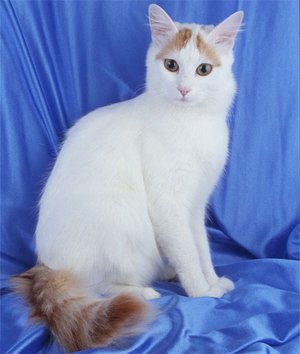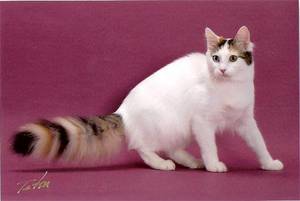Since ancient times, cats are attracted to people with its grace and mysterious behavior. Today there are several hundred breeds of cats, but one of the most notable are considered cat breed Turkish van.

In addition, vanska cat is an excellent swimmer, can not be said about the other members of the cat family. What is more remarkable breed Turkish van?
Origin story
The birthplace of van cats is considered to be Turkey, namely the Eastern Anatolia region. The breed exists since the middle Ages, but was discovered by humans only in the mid-twentieth century. For the first time on an unusually beautiful animal drew the attention of tourists from the UK Sonia Halliday and Laura Get who came to Turkey for the interesting photographs. In this country women have seen large cats with long hair white and flaming red tails. Women liked cats, they decided to take the animals with them.
A little later tourists from the UK were in for a surprise:the women went into one of the reservoirs and vanska cat also gladly went for a swim! Laura and Sonya understood that domesticated animals are a unique breed of waterfowl cats, so initiated a formal registration of the breed.
Vanska the cat was assigned to a separate breed in 1969, and received the name “Turkish cat”. In 1979 in Britain, the name was changed and the breed called “Turkish van”.
Features of the breed.
Cat breed Turkish van are large, but at the same time graceful. The weight of the animal ranges from 4-6 pounds, while the weight of the cat can reach 10 kilograms.

The breed standard according to the international organization TICA, looks like this:
- Head: the head is of medium or large size relative to their body size. The contours of the head rounded, and cheekbones are high. Chin and forehead of the cat is rounded, while the face has a neat shape.
- Eyes: van cat, they have the shape of a peach pit. The eye is slightly elongated at the outside corners. Uncommon cat breed Turkish van with bi-colored eyes, which gives the animal its unusual appearance.
- Ears: the Turkish van has a large extended at the base of the ears.
- Body: the Turkish van has a long, large, but at the same time a slender body. Also the animal has a short massive neck. Cat breed Turkish van has a broad chest and shoulders.
- Legs: the legs of the cat are of average length, with hind legs noticeably longer than the front. Paw pads are quite neat, and between the fingers are the brush.
- Tail: the Turkish van has a bushy tail of medium length. The coat color of the tail bright red.
- Coat: the coat of the Turkish van has no undercoat, but at the same time, animal hair fluffy and pleasant to the touch. Because the Turkish van is considered to be waterfowl a cat, its coat waterproof.
Turkish cat attracts attention due to its unusual color. Coat of the animal is white, but the head and the tail are marked with red markings, which cover no more than 20% cat fur. According to the breed standard, it is allowed and completely white color without any markings.
The thickness of the coat of the Turkish van cat depends on the age of the animal and time of year. The kittens fur is quite rare, but adult animals can boast of luxury “fur”. In the summer coat of the Turkish van long and thick, while in the summer vanscoy cat may be confused with short-haired.
The Turkish van is not only beautiful, but playful cat who can be an ideal pet for a person. It is worth consideringthat vanski cat is an energetic dog so he can in just a few seconds to climb to great heights, for example, on the Cabinet, and long to be there. Wanski cat loves to play and frolic, especially if you put it in the water. Despite the friendly nature of the Turkish cats, it is not recommended to keep in the same area with other Pets, because he likes to feel superior.
With regard to the relationship with the owner, the Turkish van can be considered the perfect pet. Pet feels the mood of the owner that may affect her behavior. The cat is easy to train, so if the owner can devote time and attention to training a pet, he may hope for a brilliant result.
Wanski cat abhors a closed and dark spaces, so you can keep an animal in the apartment with a small area is not recommended. Man, to think about buying a Turkish cat, you should consider that this animal doesn’t like it when it take on hands. But to sit on the neck of the owner, this animal can hardly refuse, since it loves the top. Also wanski the cat will not deny myself the pleasure to sit on the windowsill and gaze out the window at what is happening on the street.
Health and particular care
- The Turkish van has a long life expectancy. If you properly care for pet and to carefully monitor his health, he will be able to live more than 15 years. The animal is not prone to any genetic diseases, because this breed was bred in natural conditions and not as a result of selection.
- Turkish Vanir themselves active and playful, and if the landlord notes from the pet lethargy and apathy, in this case, the animal as soon as possible to show the vet.
- Consider that cats that have undergone castration may from time to time occur fatty crusts around the base of the tail. To eliminate them need to be applied on the problem areas potato flour. After a few hours glued hair should be gently combed.
- Special attention should be paid to the diet of the pet, because of the improper diet, the animal may gain extra body weight. The latter may have a negative impact on the health status of the cats and the duration of its life.
- Vanska the cat belongs to the long-haired, but to care for its wool cover is easy, and all because of a missing undercoat. Due to this feature the hair easy to comb and does not tangle. To comb a cat it 1 time in 2 weeks. It is also necessary to monitor the condition of the teeth and gums of the animal, because occasional care for the oral cavity of the animal can lead to periodontal disease.
- Despite the fact that the Turkish van loves to swim, bathe it should be no more than twice a month. To keep clean the coat of your pet, it is recommended to timely change the contents of her tray.


Cat breed the Turkish van is quite rare, which is reflected in their cost. In Russia, a pedigreed kitten can be bought not less than 7 thousand rubles (3 thousand hryvnias). The cost depends on the pedigree of the animal, its respective breed standard. To find a purebred kitten in the CIS countries is difficult because of the specialized nurseries here are very few. To bring van kitten from Turkey, but in this case you will need a special permit for the export of animal abroad.
Beauty, grace, intelligence and friendly nature – all these qualities are inherent to the Turkish van. If a person set out to contain the animal at home, he should carefully consider his decision, as the Turkish cat needs special care and living conditions.


